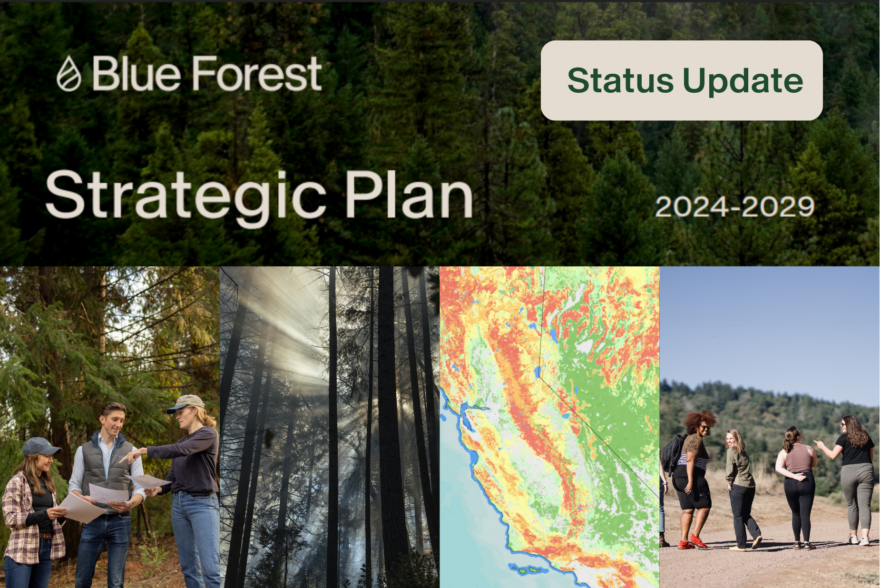One Year into Our Strategic Plan: Progress & Next Steps


At Blue Forest, our work evolves alongside the challenges we seek to solve. Now one year into our 2024-2029 Strategic Plan, we’re sharing our first progress update—a look at what we’ve accomplished, what we’ve learned, and how we’re refining our approach as we continue to scale impact.
In 2024, we made significant strides:
- $17.8 million deployed through four Forest Resilience Bonds and the California Wildfire Innovation Fund (CWIF)
- Completed capitalization for both CWIF, at $50 million, and the FRB Catalyst Facility, at over $15 million
- New funding commitments from three utility beneficiaries and one non-utility beneficiary
- 21 benefit evaluation requests completed to quantify the impact of proactive restoration
- 3 new conservation finance product concepts developed, expanding conservation finance to new geographies and restoration needs
Our work is dynamic by nature, and as projects and partnerships progress, we recognize the need for continual reflection and adaptation. So, too, is our approach to strategic planning. When we took a step back to analyze progress made in 2024, we decided to add two new objectives to our strategic plan for 2025:
- Explore and design new catalytic conservation finance products
- Provide value to conservation finance investors through best-in-class reporting, compliance, and portfolio management.
With nearly a fifth of the plan completed, we remain on track to meet our goals by 2029.
As we look ahead, 2025 marks 10 years of Blue Forest, a milestone that challenges us to both execute on what we’ve built and prepare for what’s next. This year, we are focusing on scaling proven solutions, refining new financial models, and aligning our resources to maximize impact. Wildfire risk reduction remains our top priority, alongside expanding our work in broader ecosystem restoration and watershed health.
Below, you’ll find a snapshot of our progress for the length of the strategic plan across our four strategic pillars: Organizational Capacity Building, Ecosystem Restoration Financing, Science to Advance Ecosystem and Community Resilience, and Culture of Empowerment.
| Strategic Pillar: Organizational Capacity Building | |
| Goal | Five-Year Strategic Plan Progress |
| Develop organizational capacity for a nuanced understanding of ecosystem restoration in order to design and deploy effective financial vehicles |
|
| Attract and effectively manage diverse organizational funding to enable innovation and impact |
|
| Communicate mission and impact to the public, partners, and other stakeholders |
|
| Ensure respect for Indigenous communities and values across Blue Forest projects and partnerships |
|
| Continuously advance size- and stage-appropriate internal policies and processes |
|
| Steward financial resources toward organizational health and sustainability |
|
| Steward and optimize financial resources toward organizational health and sustainability |
|
| Strategic Pillar: Ecosystem Restoration Financing | |
| Goal | Five-Year Strategic Plan Progress |
| Expand the set of financial products targeting ecosystem restoration |
|
| Deploy conservation finance products that are proven to increase the pace and scale of forest restoration and reduce catastrophic wildfires across the Western United States |
|
| Enable the next phase of Forest Resilience Bonds to achieve landscape-scale impact |
|
| Mature institutional quality investment management platform |
|
| Strategic Pillar: Science to Advance Ecosystem and Community Resilience | |
| Goal | Five-Year Strategic Plan Progress |
| Ensure Science and Research is the backbone of project and product development |
|
| Strategically and meaningfully engage with research partners and the scientific community |
|
| Strategic Pillar: Culture of Empowerment | |
| Goal | Five-Year Strategic Plan Progress |
| Foster a diverse, equitable, inclusive, and just organizational culture that enacts our organization’s values |
|
| Develop and maintain an organizational ethos rooted in empowerment, accountability, and feedback |
|
| Prioritize the well-being of our people for work-life fulfillment |
|